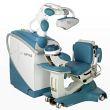Robotic Follicular unit extraction (FUE) has been marketed heavily as new state-of-the-art surgical hair restoration and as the future of hair transplantation. The makers have made many bold claims of these devices, such as Restoration Robotics, Inc, the most popular device, the Artas Robotic FUE device.
Robotic FUE is it any good?
Devices such as the Neograft or the Artas are tools for extracting grafts. Whether the tool is good or bad depends on the person using the tool. However, there are fundamental differences when selecting a robotic FUE surgeon instead of a traditional manual or motorized punch FUE.
One fundamental difference is the size of the punches. The size of the surgical punch for robotic FUE ranges from 1-1.2mm in diameter. Most surgeons who use manual and motorized punches use 0.75-1mm size punches. The difference in size is significant. While scarring is mainly physiological, there is no denying that smaller punches will leave more minor scars on average. Something to consider when looking at robotic FUE.
The benefit of utilizing the robot is to keep the quality of the grafts consistent. The quality will indeed be consistent if the surgeon uses the robot to excise the grafts. However, whether the quality is better than the grafts extracted by hand or via a motorized punch is highly debatable. That said, the learning curve for learning FUE is high. It takes years to learn how to extract healthy grafts that will yield good growth. It might be better for a surgeon who is still learning to utilize the robot in some instances. But the fact is that the world's best FUE surgeons do not use the robot.
Robotic FUE Lawsuits and Controversy
In 2018, Pomerantz Law Firm announced a class action lawsuit against Restoration Robotics, the makers of the Artas System. In 2019 a judge denied the motion to dismiss the case. The court found that the claims made by Restoration Robotics, Inc of targeted precision and clean scored incisions were a misrepresentation based on an alleged statement from a confidential witness. The biggest selling point for choosing the robot was the so-called precision and clean scored incisions.
Most of the lawsuit was based on underwhelming sales and promises that physicians alleged Restoration Robotics promised. The judge dismissed these claims. However, it does show that the initial allure for many physicians purchasing this device was to increase their practice revenue by including surgical hair restoration as a treatment option. One could assume that the allure was due to the promise of a turn-key machine that is easy to use with little experience.
Our Final Thoughts
There is no denying that many of the world's best hair transplant surgeons have had negative things to say about their experience with the Artas System. Apparently, many of their investors have negative things to say as well. That said, there are still some high-quality surgeons who utilize the Artas with success. Whether this option is best for you depends on your research. You have to ask yourself three questions, will you get better growth? Will you get better scarring? Is it financially more affordable? If you answer no to any of these questions. It might be best to choose a different option. If you have more questions about the Artas System and want to ask some world-renowned surgeons their thoughts, please schedule free virtual consultations here.

